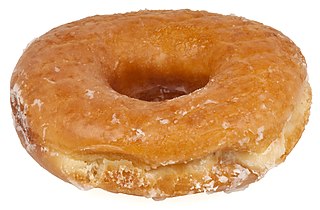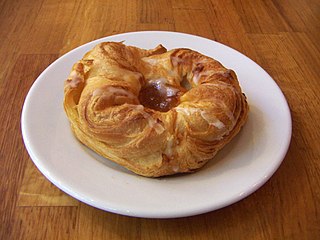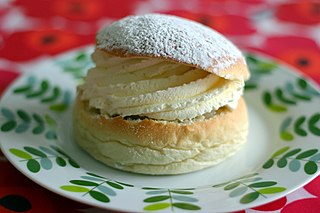
The Swedish Academy, founded in 1786 by King Gustav III, is one of the Royal Academies of Sweden. Its 18 members, who are elected for life, comprise the highest Swedish language authority. Outside Scandinavia, it is best known as the body that chooses the laureates for the annual Nobel Prize in Literature, awarded in memory of the donor Alfred Nobel.

A doughnut or donut is a type of pastry made from leavened fried dough. It is popular in many countries and is prepared in various forms as a sweet snack that can be homemade or purchased in bakeries, supermarkets, food stalls, and franchised specialty vendors. Doughnut is the traditional spelling, while donut is the simplified version; the terms are used interchangeably.

A Danish pastry is a multilayered, laminated sweet pastry in the viennoiserie tradition. It is thought that some bakery techniques were brought to Denmark by Austrian bakers, and originated the name of this pastry. The Danish recipe is however different from the Viennese one and has since developed into a Danish specialty.
The Swedish alphabet is a basic element of the Latin writing system used for the Swedish language. The 29 letters of this alphabet are the modern 26-letter basic Latin alphabet plus ⟨å⟩, ⟨ä⟩, and ⟨ö⟩, in that order. It contains 20 consonants and 9 vowels. The Latin alphabet was brought to Sweden along with the Christianization of the population, although runes continued in use throughout the first centuries of Christianity, even for ecclesiastic purposes, despite their traditional relation to the Old Norse religion. The runes underwent partial "latinization" in the Middle Ages, when the Latin alphabet was completely accepted as the Swedish script system, but runes still occurred, especially in the countryside, until the 18th century, and were used decoratively until mid 19th century.

A semla, vastlakukkel, laskiaispulla, Swedish eclair, fastlagsbulle/fastelavnsbolle or vēja kūkas is a traditional sweet roll made in various forms in Sweden, Finland, Norway, Denmark, the Faroe Islands, Iceland, Estonia, and Latvia, associated with Lent and especially Shrove Tuesday in most countries, Shrove Monday in Denmark, parts of southern Sweden, Iceland and Faroe Islands or Sunday of Fastelavn in Norway. In Sweden it is most commonly known as just semla, but is also known as fettisdagsbulle, lit. 'Fat Tuesday bun' or 'Shrove Tuesday bun'. In the southern parts of Sweden, as well as in Swedish-speaking Finland, it is known as fastlagsbulle. In Poland it is known as ptyś. In Estonia it is called vastlakukkel. In Norway and Denmark it is called fastelavnsbolle. In Iceland, it is known as a bolla and served on Bolludagur. In Faroe Islands it is called Føstulávintsbolli, and is served on Føstulávintsmánadagur. In Latvia, it is called vēja kūkas. Semla served in a bowl of hot milk is hetvägg.
Jamaican cuisine includes a mixture of cooking techniques, flavours and spices influenced by Amerindian, West African, Irish, English, French, Portuguese, Spanish, Indian, Chinese and Middle Eastern people who have inhabited the island. It is also influenced by the crops introduced into the island from tropical Southeast Asia, many of which are now grown locally. A wide variety of seafood, tropical fruits and meats are available.

Kringle is a Northern European pastry, a variety of pretzel. Pretzels were introduced by Roman Catholic monks in the 13th century in Denmark, and from there they spread throughout Scandinavia and evolved into several kinds of sweet, salty or filled pastries, all in the shape of kringle.

Cranachan is a traditional Scottish dessert. It was originally a celebration of harvest, made following the raspberry harvest in August. The dessert of cream and fresh seasonal raspberries is bolstered by Scottish oats and whisky. It has been called 'the uncontested king of Scottish desserts'. Cranachan owes its origins to crowdie, a popular breakfast in which crowdie cheese is combined with lightly toasted oatmeal, cream, and local honey. Raspberries, when in season, might be added to the dish.

Rum balls are a truffle-like confectionery cake of cookie butter flavoured with chocolate and rum. They are roughly the size of a golf ball and often coated in chocolate sprinkles, desiccated coconut, or cocoa. As their name implies, these treats contain rum. Because they are not baked, the alcohol flavour and kick are not neutralized during preparation. Rum balls are especially popular during the holiday season.

Chocolate balls are a spherical confection made of or dipped into chocolate. Other ingredients may include peanut butter or marzipan.

A chocolate truffle is a French chocolate confectionery traditionally made with a chocolate ganache centre and coated in cocoa powder, coconut, or chopped nuts. A chocolate truffle is handrolled into a spherical or ball shape. The name derives from the chocolate truffle's similarity in appearance to truffles, a tuber fungus. It was created in the city of Chambéry by the pastry chef Louis Dufour.

Kue is an Indonesian bite-sized snack or dessert food. Kue is a fairly broad term in Indonesian to describe a wide variety of snacks including cakes, cookies, fritters, pies, scones, and patisserie. Kue are made from a variety of ingredients in various forms; some are steamed, fried or baked. They are popular snacks in Indonesia, which has the largest variety of kue. Because of the countries' historical colonial ties, Koeé (kue) is also popular in the Netherlands.

Coconut cake is a popular dessert in the Southern region of the United States. It is a cake frosted with a white frosting and covered in coconut flakes.

Hen is a gender-neutral personal pronoun in Swedish intended as an alternative to the gender-specific hon ("she") and han ("he"). It can be used when the gender of a person is not known or when it is not desirable to specify them as either a "she" or "he". The word was first proposed in 1966, and again in 1994, with reference to the Finnish hän, a personal pronoun that is gender-neutral, since Finnish does not have grammatical genders. However, it did not receive widespread recognition until around 2010, when it began to be used in some books, magazines and newspapers, and provoked media debates and controversy over feminism, wokeness, gender neutrality, and parenting. In July 2014, it was announced that hen would be included in Svenska Akademiens ordlista, the official spelling dictionary of the Swedish Academy. In April 2015, the gender neutral pronoun hen and 13,000 other new words were added in a new official dictionary of the Swedish language. Today, some believe the word has lost some of its feminist-activist connotation in Sweden as it is used in the media, court rulings and books.

Gustavus Adolphus pastry is a pastry traditionally eaten every 6 November in Sweden, Gustavus Adolphus Day, the death day of King Gustavus Adolphus the Great. It is especially popular in Gothenburg, a city founded by the king.

Cookie butter is a food paste made primarily from speculoos cookie crumbs, fat, flour, and sugar. The ingredients are mixed until it becomes spreadable on a sandwich. In countries like Belgium, the Netherlands, and France, it is a common alternative to nut butter and chocolate spreads.

Esaias Tegnér Jr. was a Swedish linguist. He was professor of eastern languages at Lund University 1879-1908, lead editor of Svenska Akademiens ordbok 1913-1919, member of the Bible Commission 1884-1917, and member of the Swedish Academy from 1882 onward. Tegnér was the grandson of the well-known poet Esaias Tegnér, also his namesake, and was brother-in-law to the poet and composer Alice Tegnér.
















